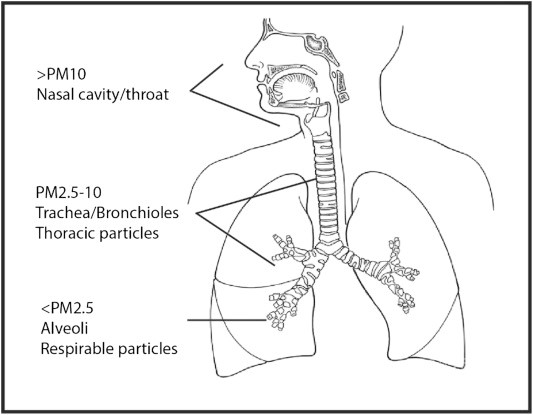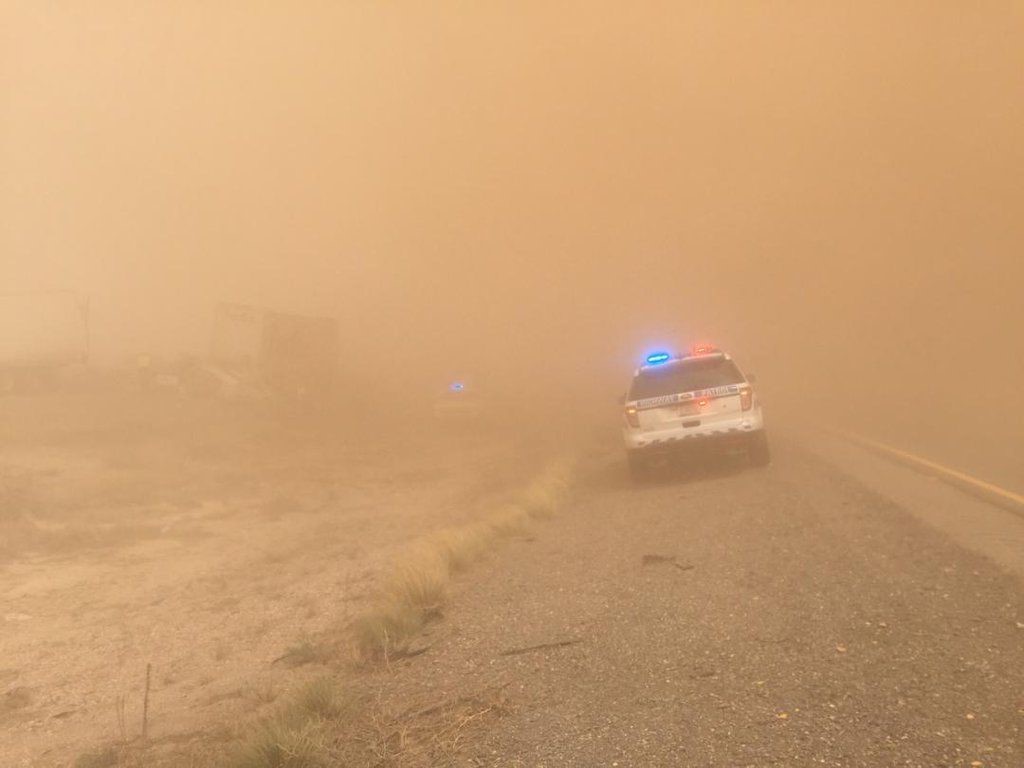Particulate matter (PM) can cause impacts on local, regional, and even global scales. Larger particulates tend to deposit quickly out of the atmosphere, but can remain suspended long enough to create local visibility reductions and transportation issues (such as on roadways or at airports) and other local impacts. Smaller particles that are either directly emitted or formed by atmospheric chemical processes can stay suspended in the atmosphere for longer periods of time and can therefore be transported greater distances, creating regional, and sometimes even global, health, visibility and deposition impacts.
Health Impacts
Figure 1-3 illustrates where and how particulates can be removed from or deposited in the human body. While the human body is efficient at filtering out the larger particles (> 10 μm) in the nasal passages, smaller particles on the scale of 5 μm get filtered out in the trachea. Fine particles can progress past the natural defenses into the bronchioles (< 2 μm) and some alveoli (< 1 μm) of the lungs. Once particles enter the lungs, the immune system sends white blood cells, called lymphocytes, to surround the particulates, protecting the body from the foreign objects. The lymphocytes settle on the alveoli walls, causing inflammation and scarring. The built-up scar tissue slows oxygen flow, making transfer of air to capillaries more difficult. This can be of particular concern to sensitive populations such as the elderly and asthmatics.

Visibility Impacts
PM in the atmosphere can absorb and scatter light, thereby reducing visibility. Episodes of impaired visibility can range in scale from local plumes (e.g., road dust) to widespread regional haze. Increased haze in the atmosphere causes objects to appear “flattened,” whitens the background, and degrades the aesthetic value of scenic vistas. For example, the view visibility along Interstate 10 in Cochise County led to road closures in 2016 (Figure 1-4). Visibility can also be a local issue because dust or smoke can decrease the visible range to distances that can be dangerous on roadways, along with other localized impacts.

Deposition and Impacts
Deposition is the removal of PM via precipitation, gravitational settling, or inertial impaction and/or absorption due to changes in airflows. Deposition as a result of precipitation is known as wet deposition and occurs through scavenging of the particle by rain, snow, clouds, or fog. Deposition via gravitational settling or inertial impaction is known as dry deposition. Deposition may adversely affect ecosystems by causing nuisance dusting, changing the pH balance, damaging plants or by adding additional nitrogen to the environment, which can result in an increase in eutrophication.
Ecosystems can be sensitive to the effects of deposition. High elevation ecosystems in the Rocky Mountains, Cascades, Sierra Nevada, southern California, and the upland areas of the eastern U.S. are generally the most sensitive to the acidifying effects of deposition due to their poor ability to neutralize acid deposition. Other potentially sensitive areas include the upper Midwest and New England. Acid deposition can also impact agricultural systems by changing the chemical properties of soil, although management of these systems with fertilizers and other soil treatments mitigate this. However, acid deposition can also damage waxy coating on leaves. In addition, many ecosystems are sensitive to the enrichment effects of nitrogen deposition, including those with short growing seasons (i.e., a limited capacity to use available nitrogen) and those that have evolved under low nutrient conditions. Nitrogen sensitive areas include high-elevation ecosystems, arid ecosystems, grasslands, and shallow bays and estuaries along the Atlantic and Gulf Coasts. The transport and deposition of dust and black carbon to the snowmelt dominated basins worldwide are of concern, especially in the springtime where the deposition increases snowpack albedo thereby enhancing snowmelt. Dust can have a physical effect on plants, coating the plant and blocking sunlight necessary for photosynthesis, causing abrasion, and blocking the stomata. Also, a dust coating can affect the intended action of pesticides and other chemicals. Depending on the chemical composition of the dust, its deposition can also alter soil chemistry.
References
4. Elmes M, Gasparon M. Sampling and single particle analysis for the chemical characterisation of fine atmospheric particulates: A review. J Enviro Manage. 2017;202:137-150. doi:10.1016/j.jenvman.2017.06.067
5. Beal T. High winds, dust could close portion of I-10 Thursday, Friday. Arizona Daily Star. https://tucson.com/news/weather/high-winds-dust-could-close-portion-of-i--thursday/article_550dc8ba-057d-5377-88dd-bb05d7124aa9.html. Published May 4, 2016. Accessed July 11, 2019.
